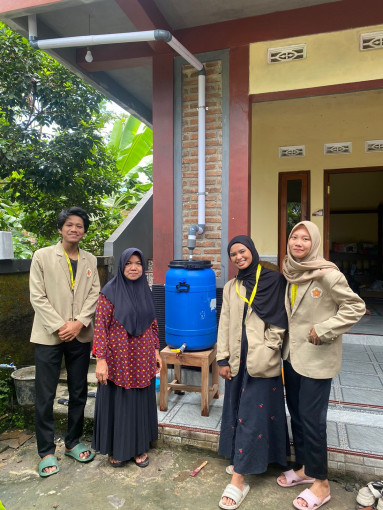A team of students from the UGM Community Service Program (KKN-PPM) devised a rainwater harvesting system adapted from the Gama Rain Filter technology for use in Ngadiharjo Village, Magelang.
This affordable device, crafted from simple materials at a cost of approximately IDR 400,000, enhances community access to clean water for various household needs.
“Our rainwater harvester is tailored for small-scale household usage, so we engineered a budget-friendly prototype. After conducting community outreach and implementing the technology, it’s now operational in one resident’s home,” explained Aushaf Mishbahuddin Muwaffaq, a member of the KKN-PPM team.
Rainwater harvesting involves collecting and storing rainwater from rooftops for irrigation, providing clean water, and reducing reliance on piped water or wells.
The distinguishing feature of the developed technology lies in its simple, cost-effective design accessible to all socioeconomic levels, requiring no specialized skills for assembly or operation.
The system comprises a tank or water storage container, typically repurposed drums, barrels, or concrete tanks, along with rainwater drainage channels constructed using PVC pipes or similar materials to direct runoff into the storage tank.
Essential components also include filters to remove debris and particles from collected rainwater before it enters the storage container. Materials like pipe clamps, rubber seals, and adhesives ensure secure, leak-free connections.
Residents have welcomed this rainwater harvesting technology with enthusiasm. KKN students intend to provide community training sessions to maximize its impact and encourage wider technology adoption.
“This rainwater collection innovation has significantly benefited my family by reducing our reliance on piped water. We use the harvested water for dishwashing, vehicle cleaning, and watering plants,” shared Tuti, a village resident.
Muwaffaq emphasized that this KKN-PPM initiative aligns with their commitment to advancing the Sustainable Development Goals (SDGs), notably achieving SDG 6 on Clean Water and Sanitation.
Its affordability and accessibility further contribute to SDG 9, emphasizing Industry, Innovation, and Infrastructure. Moreover, this innovation promotes SDG 11 on Sustainable Cities and Communities by empowering residents to implement the technology in their homes independently.
Beyond addressing immediate clean water needs, this innovation ensures the sustainability and inclusion of the technology for all. Hopefully, this initiative will inspire residents to adopt and adapt rainwater storage technology in their homes.
“Through these small steps, we can collectively contribute to a more sustainable environment and address the challenge of clean water scarcity,” Muwaffaq concluded.
Author: Gloria



